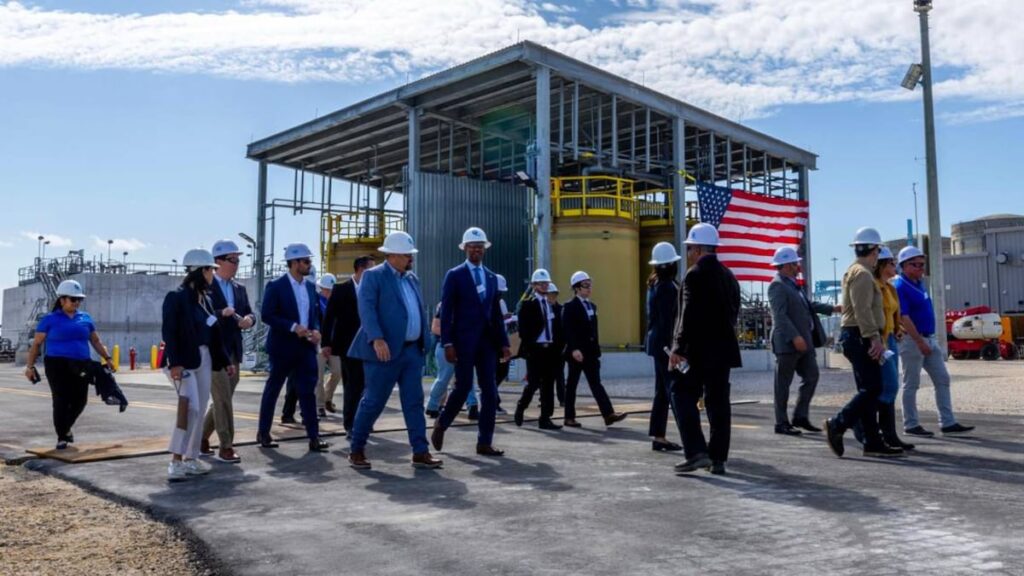MIAMI — Miami-Dade is getting much closer to its state-mandated goal of reusing partially treated wastewater rather than discharging it into the ocean.
On Wednesday, the county and Florida Power & Light debuted the FPL Miami-Dade Clean Water Recovery Center. This facility is a brand new facility designed to extract, treat, and use a large portion of the county’s wastewater to cool power generation components. turkey point factory.
County and FPL leaders touted the project as a win-win and a way to help the county meet its environmental goals and reduce the amount of water that utilities withdraw from the aquifer. .
“This project is not only environmentally friendly, it’s fiscally responsible,” Miami-Dade Mayor Daniela Levine Cava said at a press conference at the Homestead Power Plant.
“We are turning wastewater into a valuable resource,” she said. “Rather than just throwing it away, we’re putting it to good use.”
FPL CEO Armando Pimental called the new center “the project of the year” and a model of a working public-private partnership.
In 2008, the state of Florida required the city of Miami-Dade to stop piping treated wastewater into the ocean by the end of 2025. At the same time, Florida has established state standards for the amount of treated wastewater that municipalities must reuse for other purposes. Levine Cava said the project will help both.
The project was originally conceived as a larger scheme that would allow FPL to use some of this treated wastewater in the aging cooling waterways that control two nuclear power plants on the site. . It can also cause underground plumes of hypersaline water. One point threatened an adjacent drinking water well in Miami. Bill Orlove, FPL’s senior manager of communications, said plans changed at some point in the past two years.
“In the planning stages, the idea was to support backup of the Turkey Point nuclear cooling canal if necessary,” he said. “The decision was made not to do that.”
The newly constructed plant has the capacity to clean and reuse an average of 10 million gallons and up to 15 million gallons of wastewater per day.
This brings the City of Miami-Dade one step closer to its goal of recycling 60 percent of the wastewater it generates each day, a goal of approximately 117 million gallons per day. Before the FPL project began, the county was already recycling approximately 15 million gallons per day. To meet the remaining goals, the county is building similar systems at three wastewater treatment plants that will eventually be able to treat a total of 100 million gallons per day.
Check out the top stories in Tampa Bay
Subscribe to the free DayStarter Newsletter
We’ll send you the latest news and information you need to know every morning.
Everyone is registered!
Want more free weekly newsletters sent to your inbox? Get started.
consider all options
These three projects (two of which are under construction) and the FPL Center will take Miami-Dade beyond the standards it is legally required to meet.
“We are working around the clock to meet these requirements and fully agree with them,” Levine Cava said.
If this happens, Miami-Dade “will become the No. 1 utility, not just in Florida but on the entire East Coast, when it comes to industrial water reuse,” said Jennifer L. Messemer-Skrud, a spokeswoman for the Water and Sewerage Department. Ta. .
Clean enough to water the lawn
Toilets and showers flushed in South Miami-Dade end up at the South Dade Wastewater Treatment Facility. From there, it will undergo an initial wash and then be transported by a new eight-mile pipe to the Turkey Point campus.
Carlos Santamaria, Turkey Point’s senior plant engineer, pointed to a shiny new concrete facility that now processes millions of gallons each day.
The first step, he said, is to remove some nutrients from the water. Step 2 is to sieve the solids from the slurry. Step 3 is the final cleaning, which involves adding the filter and using a small amount of cleaning chemicals such as chlorine.
The end result isn’t clean enough to drink, Santamaria said, but “it could be used for irrigation.” “It has no negative impact on the environment.”
FPL uses that water to cool five natural gas generators at its Turkey Point campus, which also includes a nuclear power facility. Most of the water will evaporate into the atmosphere, Santamaria said, and the remaining water will be injected into deep injection wells 3,500 feet underground.
“Anytime you can take the straw out of the system, that’s a good thing,” said Ilera Bagge, director of government and water resistance at Black & Veatch, the engineering firm that designed the project.
This article was originally published in Florida, a multi-newsroom initiative founded by the Miami Herald, South Florida Sun-Sentinel, Palm Beach Post, Orlando Sentinel, WLRN Public Media and the Tampa Bay Times. Produced in partnership with Climate Reporting Network.

